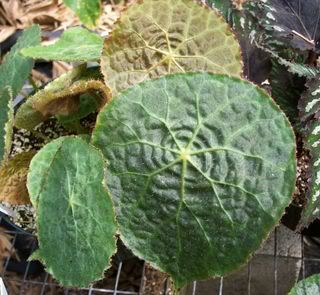Begonia Blogging
More begonias
The trouble with the world is that the stupid are cocksure
and the intelligent are full of doubt.
-- Bertrand Russell
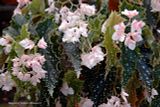
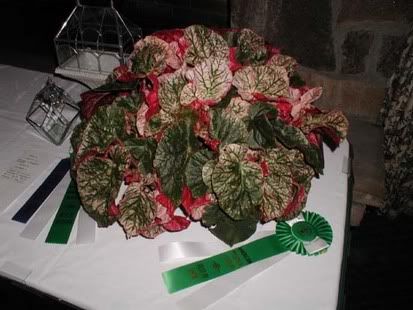
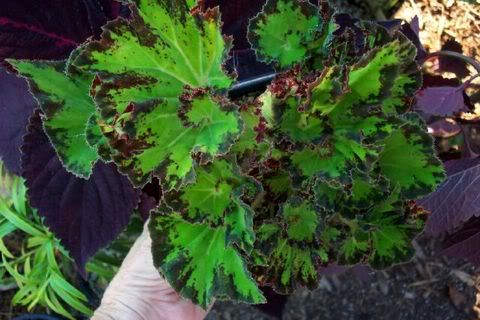

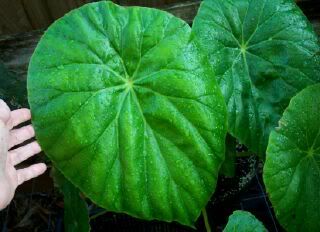
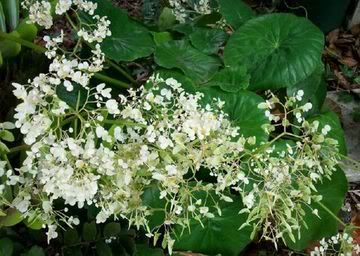
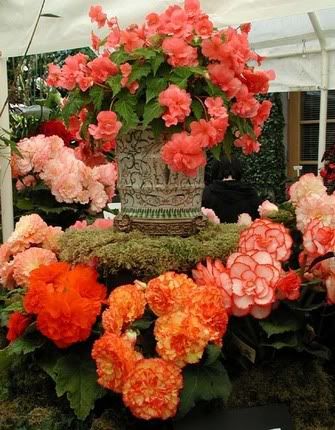

I forgot to post one last week.
The Begoniaceae family probably has the greatest variety of leaf shape, size, patterning and texture of any plant family, but even plain green can be dramatic. This rhizomatous hybrid, B. 'Oliver Twist', is a lovely shade of (what?) forest green? emerald green? I need a list of all the shades of green. It has a few very dark green, almost black, streaks here and there, which don't show up in the picture. I love the helix and the frilly edges...reminds me of a petticoat.

This begonia is rare even among collectors and has unique characteristics that make it one of the most intriguing species I've ever seen. The gray-green leaves can get nearly a foot across. The edges fold inward, giving them an umbrella-like appearance. The backs of the leaves are a striking burgandy color, and there are red scale-like appendages up and down the petioles.

New leaves emerge looking like crab claws.

This species, which used to be called Rudy's [Ziesenhenne] J-11, has not yet been officially named. It has been given a U (unidentified) number until a positive ID is made, and has been classified as a thick-stemmed begonia. This is one of those begonias that collectors put at the top of their wish list.
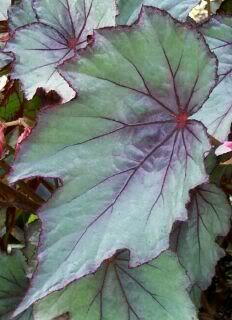


This one is an Australian hybrid by Ross Bolwell, another prolific hybridizer who keeps churning out one beauty after another. Unfortunately, because of import/export restrictions on plants, it's very difficult to get our hands on any of them. This cultivar made it to the US somehow, and I've been growing one for several years now.
B. 'Flamingo Queen' is my favorite cane-like begonia, with a height of 3'-4', prolific pink bloom clusters and enormous, long, curling spotted leaves. I've often thought that Ross really meant 'Flamenco Queen', instead of 'Flamingo Queen', because the leaves remind me of a gypsy dancer's skirt.
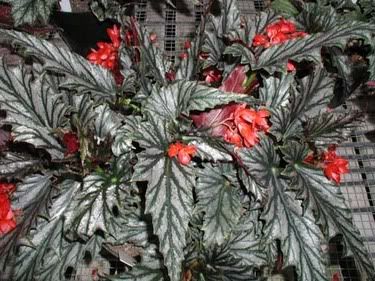
Begonia 'Lady Prado', a Brad Thompson hybrid. I love the bright orange flowers contrasting with the silver-patterned leaves. Brad is a prolific hybridizer in California with many mouth-watering creations. His Web site is the most complete reference on begonia cultivation that I've found.

There are several rex begonia hybrids that look very similar, but I think this one is B. 'Harmony's Red Robin 2'. Impossible to capture in a photo is the sparkle that you find in begonia leaves, especially in rexes. Up close, this looks like the metallic red paint used on cars. Botanists speculate that it may be a device to reflect more light to the plant, since begonias are shade lovers and often grow on the jungle floor. It's magical, whatever it is.
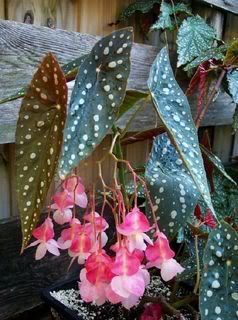
B. 'Sierra Mountain King' is a rather small cane-like begonia (up to three feet in height) displaying enormous, pendulous bloom clusters with very fuschia-like flowers in pink and white. As you can see, each bloom is almost as long as my finger.
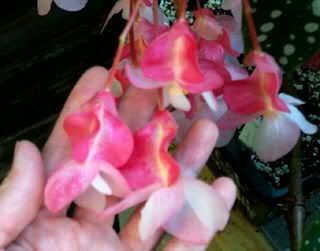
This is a very showy cane that doesn't get huge, so it's great as a patio plant in summer and a houseplant in winter for the northern growers. It's a Cynthia Bishop hybrid (maculata x lubbersii).
This is what's known as a primary cross, which is a hybrid formed by crossing two species, in this case, the two Brazilian species, maculata and lubbersii, both discovered in the 1800's. Every spotted cane begonia that you see can be traced back to B. maculata. You will always get very similar plants by crossing two species, whereas species-hybrid crosses, or hybrid-hybrid crosses, can produce an almost endless number of different results from the same seed pod, depending upon the genetic variation contained in the hybrid. Some are better parents than others, and some are sterile.
This was one of my favorite canes, but the hurricanes blew it away. I'll find another one some day.
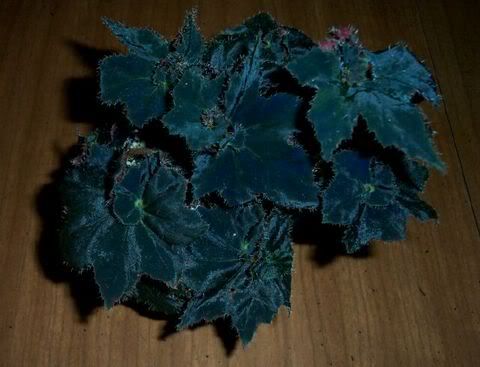
I'm fascinated by black leaves, and there are a number of begonia hybrids to choose from. This one was labeled B. 'Mimi' when I got it, but there doesn't seem to be any record of a hybrid by that name. In any case, I love it! The velvety leaves are enhanced with white eyelashes and a double helix and are about as black as begonia leaves can get. This photo illustrates a phenomenon that I've noticed with dark begonia leaves. In the right light, an iridescent blue color shows through.
